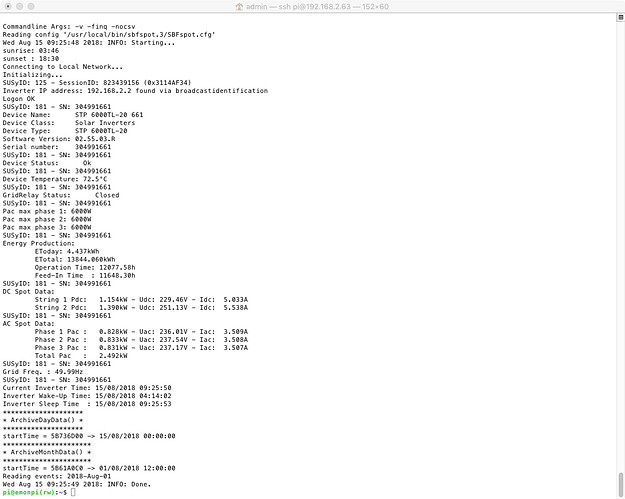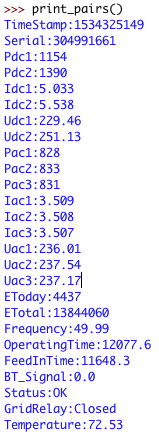Exciting. I have SBFSpot running along-side emonCMS on a rPi 3B+.
This uploads solar PVdata to PVoutput.org.
SBFSpot is a very well maintained program with good documentation, and retrieves 5 minute resolution data from a wide range (possibly all) SMA solar inverters via bluetooth or ethernet.
SBFSpot works by downloading real-time and archival data via bluetooth or ethernet, storing it in a local database on the Pi for a user-defined timeframe (days, months, years…). SQLite is used to create and manage the database. An upload Daemon reads the database and sends the data to PVOutput.org.
Another highlight was the first run from SSH 
Next steps are to create a script to read the database and bring data into emonCMS. I plan to use Python’s pySQlite. I have no idea how to go about this yet and the hours I’ll need in front of a screen… well I’ll have to keep a close eye on the caffeine intake to not go mad  Help would be much appreciated. I hope to create a module which fits with emonHub… again, not entirely sure how to go about that. I recognise there’s a bluetooth-sma emonHub module, but I saw it was having problems with recent updates of emoncms and I wanted to use an ethernet connection instead of bluetooth.
Help would be much appreciated. I hope to create a module which fits with emonHub… again, not entirely sure how to go about that. I recognise there’s a bluetooth-sma emonHub module, but I saw it was having problems with recent updates of emoncms and I wanted to use an ethernet connection instead of bluetooth.
EDIT: Redis issue posted to separate thread.
EDIT: Also, the UploadDaemon which is added to /etc/rc.local with lines:
#Start SBFspotUploadDaemon
sudo /usr/local/bin/sbfspot.3/SBFspotUploadDaemon
Fails to start upon reboot. The issue, is I’m fairly sure, is that the system is read-only upon reboot, and the Daemon is therefore unable to write to the log file I’ve created according to the SBFSpot setup guide. I believe I can change the log location. Can the Pi be started in write mode? Or can I give the daemon permisson?
The SBFSpot data is going to /home/pi/smadata/
Would the best thing to do to put the SBFSpot data in /home/pi/data/smadata/ ?
I think I’d originally loaded emonSD-13Jun18.img
Edit: The permissions error was resolved by pointing SBF to the read/write ~/data/ folder, however future images of emonCMS will have the write lock function removed, the problem shouldn’t exist after the next release.


